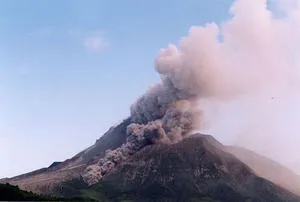
Helping assess volcanic hazards is the next task for National Oceanography Centre scientists working in the Caribbean Sea.
Following the successful investigation of hydrothermal vents in the Cayman Trough, scientists on board the RRS James Cook have moved on to study the volcanic island of Montserrat for the next leg of the expedition. The research is funded by the Natural Environment Research Council.
Led by Dr Peter Talling, the scientists will be testing new instruments that can sample the debris from volcanic eruptions and landslides. The 1997 volcanic event resulted in a pyroclastic surge cloud that travelled at up to speeds of 80 metres a second (just under 180mph) and destroyed the town of St Patrick’s.
Pete Talling said, “Monserrat continues to be volcanically active. Understanding eruption and landslide histories can help us understand the risks of future events. We will be mapping and coring the seafloor deposits from ’97 and deposits from two massive underwater landslides which dwarf recent eruptions.
“We will be sampling with our new vibra-corer as it offers an opportunity to recover sediments rich in coarse sand, which conventional coring equipment cannot penetrate. Conventional coring in these settings is hazardous and unwise owing to the chaotic nature of the seafloor terrain. We are hoping the vibra-corer will unlock details of how coarse sediments are distributed and deposited on the seafloor by sediment flows.”
The vibra-corer will be attached to Isis, the deep-diving ROV (Remotely Operated Vehicle) and will enable precision placement of the corer on the seafloor. Up until now, geologists have only been able to use conventional coring equipment that can only recover finer grained sediments.
Obtaining samples of the deposits close to the island can highlight key geohazard factors. The results will go to the Montserrat Volcano Observatory staff to help with volcanic hazard assessment.
Sediment flows are often very damaging to infrastructure like cables and pipes. There is considerable interest from companies on how to mitigate the destructive impact of these flows.